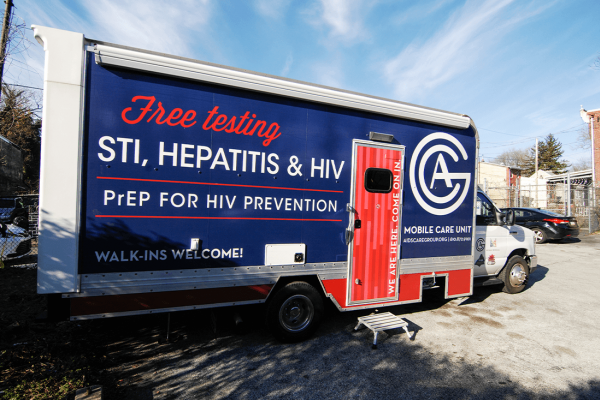The United States has seen a steady rise in sexually transmitted infections, most notably a steep rise in syphilis cases.
The Centers for Disease Control and Prevention reported an over 1,000 percent rise in syphilis cases between 2012-2022, with a 32 percent rise from 2020 to 2021 alone, which doctors attribute to the pandemic’s strain on the health care system.
Accompanying the adult infection rate has been an alarming rise in congenital cases of the infection — meaning it is passed from pregnant mother to child — which has obstetricians like Yolanda Lawson concerned. The infection can lead to blindness, liver problems, death, and other devastating effects.
“As an [obstetrician], congenital syphilis is a travesty to me, because it’s preventable,” said Lawson, who also serves as president of the National Medical Association, the largest organization representing African American physicians. Furthermore, she said, it’s not difficult to prevent.
In the past, education, testing, and medication reduced the number of overall syphilis cases and congenital cases. U.S. syphilis cases dropped precipitously through the 1990s in the U.S. before the increase starting in 2000. Lawson said the same strategy that worked previously can work again, but it will need increased investment, which will require political will and social commitment.
“There is absolutely no way we should be seeing the explosion of congenital syphilis in this country,” Lawson said. “We are resourced.”
She also said that states can help address congenital infections by mandating testing for STIs throughout pregnancy and up to birth, Lawson said. Only six states currently require syphilis testing at delivery for all parents, and only eight other states require it for people who are deemed high-risk. That protocol would be “low hanging fruit,” she said, the easiest way to get antibiotics to both parent and child before too much damage occurs.
However, treating later stages of syphilis requires multiple injections of antibiotics, and access can be a barrier to people completing their treatment. In her Dallas clinic, the national shortage of the antibiotic used to treat syphilis infections has made it difficult or impossible to offer treatment at her clinic, she said, even though it is easier and less expensive for her clients than going to the hospital.
The rise in congenital syphilis maps fairly consistently with other inequities in the American health care system. The CDC found that inadequate testing and inadequate treatment were the two main causes of missed infections in the parents that led to congenital syphilis in their babies. Inadequate testing, largely a function of underregulation and stigma, was the most common cause of congenital syphilis in white, Native American, and Pacific Islander populations. Inadequate treatment, a function of lack of access to health care in general, was the most common cause among Black and Hispanic populations.
In allocating testing and treatment resources, state health departments and regulations will play a large role, Lawson said, so for the sake of efficiency, it’s important to focus on the five states that accounted for 58 percent of congenital syphilis cases in 2021: Texas, Florida, Louisiana, Arizona, and California. Working in these states — three of which are among the most populous in the country — resources can become more standardized. The same goes for the best source of STI prevention in the first place, she said: education.
Lawson said that while some states could do better on sex education in public schools — including some of the states with the highest STI rates — education is also a community endeavor that extends into adulthood.
One thing Lawson tries to emphasize with her colleagues is the need for doctors to have candid conversations with their patients about the risk of STIs, including syphilis. The conversation needs to be private, non-judgemental, and thorough. If a test comes back positive, Lawson’s practice always extends treatment or treatment assistance to partners as well. Again, she said, standardizing those tests would make the conversation easier.
Education, testing, and treatment in the community at large is important, especially among populations with increased barriers to health care, said Erika Borrego, CEO of Corazón San Antonio, a holistic ministry to unhoused people, offering meals, case management, clothes, hygiene kits, and more. As part of the ministry’s harm reduction initiative, Corazón offers safe-sex education and supplies both within and outside the churches where they work. The ministry hopes to serve as a reminder in San Antonio that the church and the lived experiences of homelessness, addiction, abuse, and mental illness — all of which add to the likelihood of exposure to STIs — should not be hidden from each other.
“The role I’m seeing the faith community play in this space is creating an environment that allows services to be offered and accessed by the community,” Borrego said.
So many churches have real estate and space in urban centers near unhoused and vulnerable populations. Opening up that space to professionals, especially those like the Corazón team, primarily staffed with people who have lived experience similar to their clients, can be a practical help, and a powerful message to reduce stigma.
“They’ve been there and they’ve learned how important it is to take care of yourself and connect to doctors who can protect you and your baby,” she said.
Those doctors who work with vulnerable populations need to follow the same protocols they would for taking a social and sexual health history from any patient, but with added care due to the likelihood of trauma, said Mari Lowe, a nurse practitioner at Christ House, a resident medical facility for people experiencing homelessness in Washington, D.C. Open-ended, non-judgemental questions on everything from pronouns to housing and sexual partners are important. The more open the conversation, the more likely the practitioner will get the information they need to best help the client, Lowe explained in a blog post on the subject.
They also need to be cognizant of the barriers to treatment, Lowe said in an email. Prescriptions for STI treatment can be overwhelming, because they involve a trip to the pharmacy to get medication or a return to the hospital or clinic to get multiple rounds of injections. As doctors offices rely more on patient portals for scheduling and follow-up, Lowe said, unhoused people are at an increased disadvantage, as many do not have a consistent address or phone number to provide for the account, and most don’t have consistent or private computer access. Doctor’s offices and clinics can keep all of this in mind when creating a treatment plan.
Even with the best practices suggested by Lawson and Lowe, however, the prospect of talking to a doctor about potential risks to a pregnancy can be overwhelming. The more barriers, the more support is needed, Borrego said. The education and support Corazón offers are high touch and highly personalized — everything healthcare tends not to be. Her staff will go as far as to go with clients to medical appointments if they are having trouble working up the courage to talk to their doctors about STI treatment plans and, sometimes, pregnancy. “We’ll hold their hand through that if we need to,” Borrego said.
Got something to say about what you're reading? We value your feedback!







